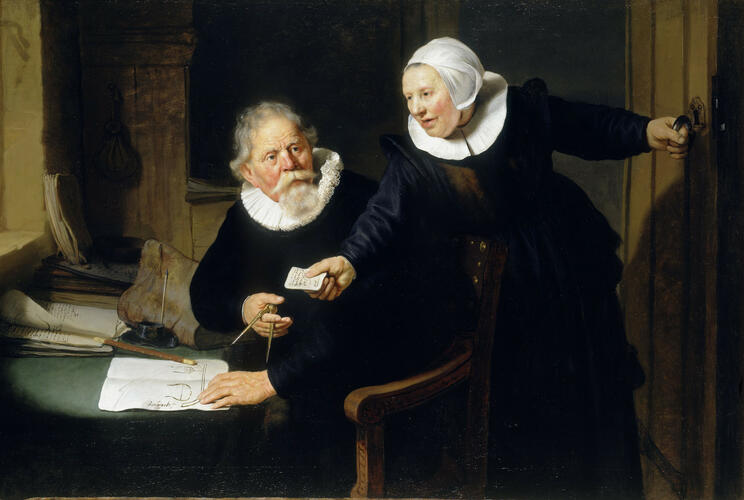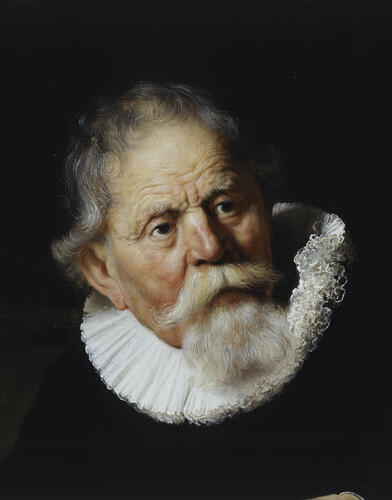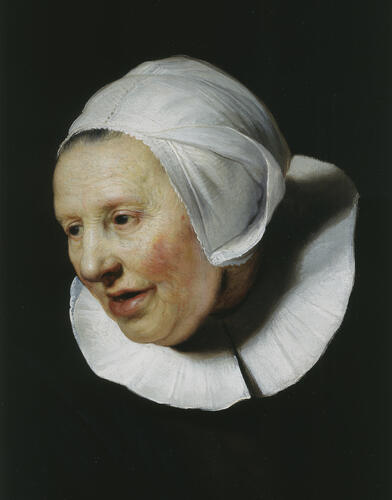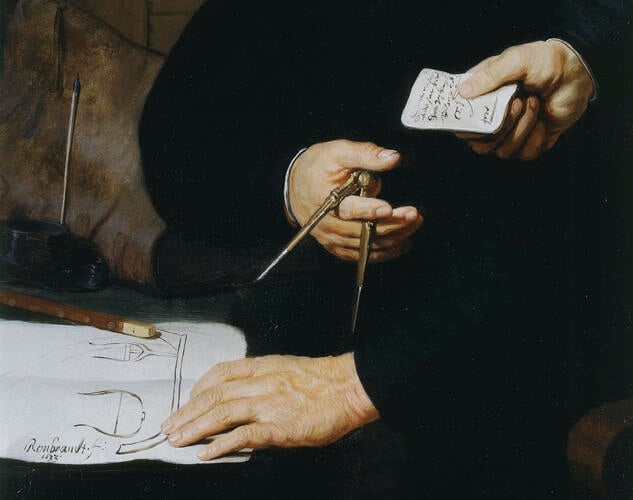-
1 of 253523 objects
"The Shipbuilder and his Wife": Jan Rijcksen (1560/2-1637) and his Wife, Griet Jans (before 1562-1652) Signed and dated 1633
Oil on canvas | 113.8 x 169.8 cm (support, canvas/panel/stretcher external) | RCIN 405533

Rembrandt van Rijn (Leiden 1606-Amsterdam 1669)
"The Shipbuilder and his Wife": Jan Rijcksen (1560/2-1637) and his Wife, Griet Jans (before 1562-1652) Signed and dated 1633

Rembrandt van Rijn (Leiden 1606-Amsterdam 1669)
"The Shipbuilder and his Wife": Jan Rijcksen (1560/2-1637) and his Wife, Griet Jans (before 1562-1652) Signed and dated 1633

Rembrandt van Rijn (Leiden 1606-Amsterdam 1669)
"The Shipbuilder and his Wife": Jan Rijcksen (1560/2-1637) and his Wife, Griet Jans (before 1562-1652) Signed and dated 1633




-
Traditionally called The Shipbuilder and his Wife, this couple were identified in 1970 as Jan Rijcksen (1560/2-1637) and his wife Griet Jans. He was a shareholder in the Dutch East India Company and from 1620 their master shipbuilder; both were Roman Catholics. He is shown working on what looks like a treatise on shipbuilding rather than a specific design, with inscriptions on the various papers naming the sitter, the artist and the date, 1633. The only object not immediately identifiable is the instrument for drawing the curving planks running lengthways down a ship’s hull.
Married couples are usually shown at this date as two separate portraits, with the husband hung to the left (as we look at it, that is on the wife’s right hand), often with some gestures or glances linking the two. Rembrandt has created a composition as if these two portraits are run together into a single image. This means that the figures overlap and their interaction is more vivid: we are to imagine that Griet Jans has burst into the room (her hand still on the door), interrupting her husband with a message which seems to her (if not to him) of the utmost urgency. Everything about her expresses breathless anxiety; he seems simply irritated. We must imagine that there is a sort of apposite comedy in this presentation which the sitters recognised, acknowledged and enjoyed. The image could also be read as a writer inspired by his Muse.
This belongs to a time when Rembrandt was most successful and fashionable as a portrait painter. His art was also at its most naturalistic, especially in the depiction of textures and surfaces, which are here described in great fidelity, neither glossing over nor revelling in the leathery, weather-beaten skin and white, tobacco-stained hair of his ancient sitters. At this date and subsequently Rembrandt experimented with a metaphorical deployment of light, suggesting human warmth or spirituality rather than observable phenomena. This can be seen especially in his Old Woman of 1630 (CW 158, 405000). By contrast the light here is almost completely natural, flooding the space from the window visible at the left edge, catching each form at an angle and revealing its detail and texture. It is this natural light which is developed by Rembrandt’s pupil, Gerrit Dou, as can be seen in his Girl Chopping Onions of 1647 (CW 42, 406358).
Inscribed on the paper with a drawing of a ship: 'Rembrandt. f: / 1633'.Provenance
Purchased by Lord Yarmouth at the Lafontaine sale (Christie's 12 June 1811), on behalf of George IV when Prince Regent; recorded in the Blue Velvet Room at Carlton House in 1819 (no 47), where it appears in Pyne's illustrated Royal Residences of 1819 (RCIN 922184); in the Picture Gallery at Buckingham Palace in 1841 (no 29)
-
Medium and techniques
Oil on canvas
Measurements
113.8 x 169.8 cm (support, canvas/panel/stretcher external)
143.1 x 197.7 x 9.5 cm (frame, external)
Other number(s)
Alternative title(s)
Jan Rijcksen (1560/2-1637) & his wife, Griet Jans
"The shipbuilder and his wife"